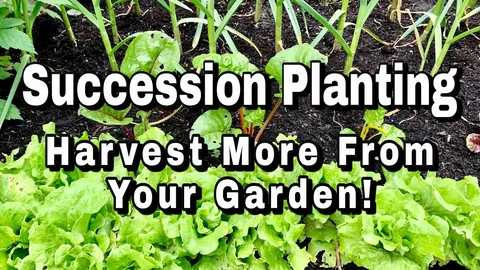Introduction
Succession planting is a strategic gardening technique employed to maximize space and extend the growing season by planting crops in a series of sequential intervals rather than all at once. This method ensures a continuous harvest throughout the growing season, thereby optimizing yield and utilizing garden space efficiently.

What is Succession Planting?
Succession planting involves planting different crops or varieties in the same space one after the other, typically as soon as the previous crop is harvested or reaches maturity. This method allows gardeners to make the most of their growing space and prolong the productivity of their garden beds.
Why Should You Do It?
Continuous Harvest
By staggering plantings, gardeners can ensure a continuous supply of fresh produce throughout the growing season, rather than experiencing a glut followed by scarcity.
Optimal Space Utilization
Succession planting enables gardeners to maximize the use of available space by ensuring that crops are always growing and producing, minimizing empty spaces in the garden beds.
Extended Growing Season
Planting different crops in succession allows for the extension of the growing season, as new crops can be planted to replace those that have been harvested or have finished producing.
Disease and Pest Management
Rotating crops through succession planting can help reduce the buildup of pests and diseases that target specific plant species, as well as replenish soil nutrients.
Increased Yield
By maintaining a constant supply of crops throughout the season, gardeners can increase overall yield and make the most of their gardening efforts.
How to Implement Succession Planting?
Planning
Start by creating a planting schedule based on your local climate, frost dates, and the specific requirements of the crops you intend to grow. Consider factors such as maturity dates, spacing requirements, and crop compatibility.
Crop Selection
Choose crops that are suitable for succession planting, such as leafy greens, radishes, carrots, and beans, which have relatively short growing seasons and can be harvested multiple times.
Timing
Determine the appropriate timing for successive plantings based on the days to maturity of each crop and the length of your growing season. Aim to plant new crops as soon as space becomes available after harvesting the previous crop.
Soil Preparation
Prepare the soil between plantings by incorporating compost or organic matter to replenish nutrients and improve soil structure. Consider using cover crops during fallow periods to prevent soil erosion and suppress weeds.
Maintenance
Provide proper care and maintenance to ensure the health and productivity of successive plantings, including regular watering, mulching, and pest management. Monitor soil moisture and fertility levels to support optimal growth.
Expert Recommendations
According to the United States Department of Agriculture (USDA), succession planting is a valuable technique for maximizing garden productivity and ensuring a consistent food supply throughout the growing season. The USDA’s Plant Hardiness Zone Map can help gardeners determine the appropriate planting times for their region.
The National Gardening Association (NGA) recommends succession planting as a sustainable gardening practice that can help reduce waste and increase self-sufficiency. Their online resources provide valuable information and tips for implementing succession planting in home gardens.
Dr. Mary Smith, a horticulture expert from the University of Horticulture Sciences, emphasizes the importance of proper planning and timing in succession planting. According to Dr. Smith, strategic crop selection and timely planting are key factors in achieving success with this gardening technique.
In conclusion, succession planting is a valuable strategy for maximizing garden productivity, extending the growing season, and making the most of limited space. By following expert recommendations and implementing proper planning and maintenance practices, gardeners can enjoy a continuous harvest of fresh produce throughout the year.
What is succession planting?
Succession planting is a gardening technique where crops are planted in a staggered manner, one after another, to ensure a continuous harvest throughout the growing season.
How does succession planting work?
Succession planting involves planting new crops as soon as the previous ones are harvested or reach maturity. This ensures that garden beds remain productive and yield fresh produce over an extended period.
What are the benefits of succession planting?
Succession planting offers several benefits, including continuous harvests, optimal space utilization, extended growing seasons, improved disease and pest management, and increased overall yield from the garden.
What types of crops are suitable for succession planting?
Crops with short growing seasons and those that can be harvested multiple times, such as leafy greens, radishes, carrots, beans, and some herbs, are well-suited for succession planting.
How do I know when to plant successive crops?
Timing for successive plantings depends on factors such as the days to maturity of each crop, local climate, and frost dates. Gardening resources, local agricultural extensions, and planting calendars can help determine the best timing for your region.
Do I need special equipment or tools for succession planting?
Succession planting typically doesn’t require special equipment beyond standard gardening tools. However, having a good understanding of crop rotation, soil preparation, and basic gardening techniques is essential for success.
Is succession planting suitable for all garden sizes?
Succession planting can be adapted to gardens of various sizes, from small raised beds to larger plots. It’s particularly beneficial for maximizing productivity in limited spaces, but it can also be applied to larger gardens to maintain a steady supply of fresh produce.
Can I use succession planting in container gardens?
Yes, succession planting can be applied to container gardens as well. Choose compact varieties of plants and ensure containers have adequate drainage to support healthy growth. Additionally, replenish soil nutrients between plantings with compost or organic fertilizers.
How do I prevent overcrowding and competition among successive plantings?
Proper spacing and timing are crucial to prevent overcrowding and competition among plants. Follow spacing recommendations for each crop and stagger plantings accordingly to allow sufficient room for growth.
Should I do succession planting in my garden?
Whether you should do succession planting depends on your gardening goals, available space, and willingness to invest time and effort in managing successive plantings. If you aim to maximize productivity and enjoy a continuous harvest of fresh produce, succession planting is definitely worth considering.
- Lip Filler London – Lip Augmentation & Natural Lip Enhancement - December 16, 2025
- Tennessee’s THC Beverage Market - June 5, 2025
- Top THC Infused Seltzers in Delaware - June 5, 2025




